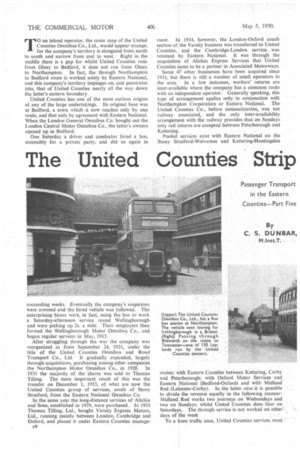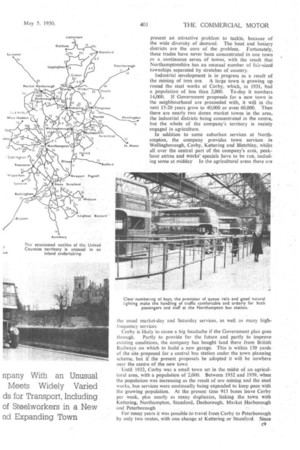The United Counties Strip
Page 44

Page 45

Page 46

If you've noticed an error in this article please click here to report it so we can fix it.
TO an inland operator, the route map of the United Counties Omnibus Co., Ltd., would appear strange, for the company's territory is elongated from north to south and narrow from east to west. Right in the middle there is a gap for whilst United Counties runs from Olney to Bedford, it does not run from Olney to Northampton. In fact, the through Northampton to Bedford route is worked solely by Eastern National, and this company's territory impinges on, and penetrates into, that of United Counties nearly all the way down the latter's eastern boundary.
United Counties has one of the most curious origins of any of the large undertakings. Its original base was at Bedford, a town which it now reaches only by one route, and that only by agreement with Eastern National. When the London General Omnibus Co. bought out the London Central Motor Omnibus Co., the latter's owners opened up in Bedford. . One Saturday a driver and conductor hired a bus, ostensibly for a private party, and did so again in succeeding weeks. Eventually the company's suspicions were aroused and the hired vehicle was followed. The enterprising hirers were, in fact, using the bus to work a Saturday-afternoon service round Wellingborough and were picking up 2s, a mile. Their employers then formed the Wellingborough Motor Omnibus Co., and began regular services in May, 1913.
After struggling through the war the company was reorganized as from September 24, 1921, under the title of the United Counties Omnibus • and Road Transport Co., Ltd It gradually expanded, largely through acquisitions, purchasing among other companies the Northampton Motor Omnibus Co., in 1928. In 1931 the majority of the shares was sold to Thomas Tilling. The most important result of this was the transfer on December 1, 1933, of what are now the United Counties group of services, south of Stony Stratford, from the Eastern National Omnibus Co.
In the same year the long-distance services of Allchin and Sons, established in 1929, were purchased. hi 1933 Thomas Tilling, Ltd., bought Varsity ExpreSs Motors, Ltd., running mainly between London, Cambridge and Oxford, and placed it under Eastern Counties manage c8 ment. In 1934, however, the London-Oxford •coach section of the Varsity business was transferred to United Counties, and the Cambridge-London service was retained by Eastern National, It was through the acquisition of Allchin Express Services that United Counties came to be a partner in Associated Motorways.
Some 47 other businesses have been acquired since 1931, but there is still a number of small operators in the area. In a few instances, workers' returns are inter-available where the company has a common route with an independent operator. Generally speaking, this type of arrangement applies only in conjunction with Northampton Corporation or Eastern National. The United Counties Co., before nationalization, was not railway associated, and the only inter-availability arrangement with the railway provides that on Sundays only rail returns are accepted between Peterborough and Kettering.
Pooled services exist with Eastern National on the Stony Stratford-Wolverton and Kettering-Huntingdon
routes; with Eastern Counties between Kettering, Corby and Peterborough; with Oxford Motor Services and Eastern National (Bedford-Oxford) and with Midland-. Red (Leicester-Corby). In the latter case it is possible to divide the revenue equally in the following manner: Midland Red works two journeys on Wednesdays and two on Sundays, whilst United Counties does four on Saturdays. The through service is not worked on other days of the week
To a keen traffic man, United Counties services must
present an attractive problem to tackle, because of the wide diversity of demand. The boot and hoSiery districts are the core of the problem. Fortunately, these trades have never been concentrated in one town or a _ continuous series of towns, with the result that Northamptonshire has an unusual number of fair-sized townships separated by stretches of country.
Industrial development is in progress as a result of the mining of iron ore. A large town is growing up round the steel works at Corby, which, in 1931, had a population of less than 2,000. To-day it numbers 14,000. If Government proposals for a new town in the neighbourhood are proceeded with, it will in the next 15-20 years grow to 40,000 or even 60,000. Then there are nearly two dozen market towns in the area, the industrial districts being concentrated in the centre, but the whole of the company's territory is mainly engaged in agriculture.
In addition to some suburban services at Northampton, the company provides town services in Wellingborough, Corby, Kettering and Bletchley, whilst all over the central part of the company's area, peakhour extras and works' specials have to be run, including some at midday In the agricultural areas there are
the usual market-day and Saturday services, as well as many highFrequency services.
Corby is likely to cause a big headache if the Government plan goes
through. Partly to provide for the future and partly to improve existing conditions, the company has bought land there from British Railways on which to build a new garage. This is within 150 yards of the site proposed for a central bus station under the town planning scheme, but if the present proposals be adopted it will be nowhere near the centre of the new town Until 1932, Corby was a small town set in the midst of an agricultural area, with a population of 2,000. Between 1932 and 1939, when the population was increasing as the result of ore mining and the steel works, bus services were continually being expanded to keep pace with the growing population. At the .present time 913 buses leave Corby per week, plus nearly as many duplicates, linking the :town with Kettering, Northampton, Stamford, Desborough, Market ,llarborough and Peterborough . For many years it was possible to travel from Corby to Peterborough by only two routes, with one change at Kettering or Stamford. Since
a direct service was introduced 11 months ago, it has been operating at a considerable loss.
Westwards, the connection to Market Harborough works on only three days a week because, the management of the company alleges, there is no community of interest. With respect to the operator's greater local knowledge, I feel that this is not looking quite far enough ahead. If Corby follows the usual pattern it will, as it grows, become a powerful magnet.. Moreover, it is on an important west-east trunk road.
Scope for Coach Service For many years I have been convinced that the inadequancy of the train services across this part of England, i.e., from Birmingham to Peterborough and King's Lynn, offers excellent scope for an express coach service, which would naturally go via Coventry, Lutterworth, Market Harborough and Corby. All these places (except Coventry) are difficult to reach from the West Midlands except by bus. The Midland Red is already working • three times a day between Coventry and Market Harborough.
I suggest that the three companies concerned—Midland Red, United Counties and Eastern Counties—might try to improve the existing arrangements by experimenting, in the summer of 1950, with a limited-stop service between Birmingham and Peterborough over this route. To start with it might work twice a day on Mondays, Fridays and Saturdays, later building up to a daily service.
Except where a route is common with other operators, such as Northampton Corporation, workers' daily return tickets are not issued, but five-, sixand seven-day tickets are used. The seven-day tickets are primarily for DSC on services to Corby, where there is a dual set of shifts, which change at (a) 6 a.m., 2 p.m., 10 p.m., and (b) 7 a.m., 3 p.m. and 11 p.m. Ordinary return tickets, with few exceptions, are not issued before 9 a.m.
Most conductors are equipped with Willebrew machines, fitted with an attachment to print the direc Lion and stage number on the tickets, but a number of Setright speed model machines has recently been issued Both types of ticket have provision for indicating a change of vehicle where this is allowed on a through fare.
Before Tilling took control, United Counties head quarters were at Irthlingborough. The main repair works were also there, although for some years bodybuilding was carried out at Desborough. In 1938, the headquarters and main overhaul works were moved to new premises in Houghton Road, Northampton. Desborough is now only an ordinary running garage, whilst the Irthlingborough depot has been replaced by a dormy shed. In addition, there are depots at Wellingborough, Kettering, Rushden, Stony Stratford and Oxford. To these depots are attached the following dormy sheds and out-stations:
Northampton: Welford, Long Buckby, Silverstone, Daventry, Aylesbury Kettering: Desborough, Thrapston, Market Harborough, Stamford. Wellingborough: Irthlingborough, Olny. Stony Stratford: Fenny Stratford, Bristol Buses Predominate Twenty years ago the (let waS almost entirety of Leyland make, but in recent years Bristol vehicles have become predominant. In the fleet of 300 vehicles, which includes 26 coaches, 130 are of Leyland manufacture, 10 A.E.C.' and eight Bedford. Most of the remainder are of Bristol manufacture. Double-deckers of all makes total 120 and are all of the low-bridge type. The normal distribution of the vehicles is as follows (dormy sheds are included under the main garage): Northampton, 100; Kettering, 100; Wellingborough and Rushden, 70; Stony Stratford, 20; Oxford, 10.
In 1948, 9,384,666 bus-miles were worked and 37,664,732 passengers carried. The chief officers are Mr. R. Pittard (director and general manager), Mr. R. G. Howe (traffic manager), Mr. G. L. Lindsay. (chief engineer), and Mr. F. T. J. Merriman (secretary).
























































































